Definition: Decision tree analysis is a powerful decision-making tool which initiates a structured nonparametric approach for problem-solving. It facilitates the evaluation and comparison of the various options and their results, as shown in a decision tree. It helps to choose the most competitive alternative.
It is a widely used technique for taking crucial decisions like project selection, cost management, operations management, production method, and to deal with various other strategic issues in an organization.
Content: Decision Tree Analysis
What is a Decision Tree?
A decision tree is the graphical depiction of all the possibilities or outcomes to solve a specific issue or avail a potential opportunity. It is a useful financial tool which visually facilitates the classification of all the probable results in a given situation.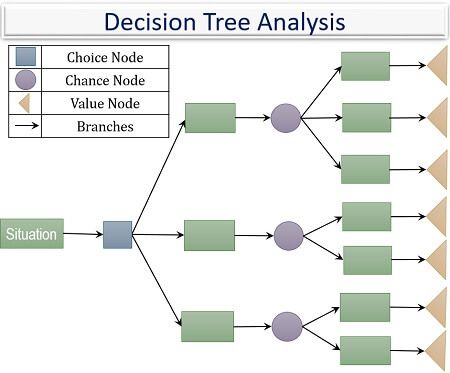
Terminologies Used
Let us understand some of the relevant concepts and terms used in the decision tree:
- Root Node: A root node compiles the whole sample, it is then divided into multiple sets which comprise of homogeneous variables.
- Decision Node: That sub-node which diverges into further possibilities, can be denoted as a decision node.
- Terminal Node: The final node showing the outcome which cannot be categorized any further, is termed as a value or terminal node.
- Branch: A branch denotes the various alternatives available with the decision tree maker.
- Splitting: The division of the available option (depicted by a node or sub-node) into multiple sub-nodes is termed as splitting.
- Pruning: It is just the reverse of splitting, where the decision tree maker can eliminate one or more sub-nodes from a particular decision node.
Steps in Decision Tree Analysis
Now, you must be wondering, how to initiate the decision tree analysis for solving a particular issue?
Following steps simplify the interpretation process of a decision tree: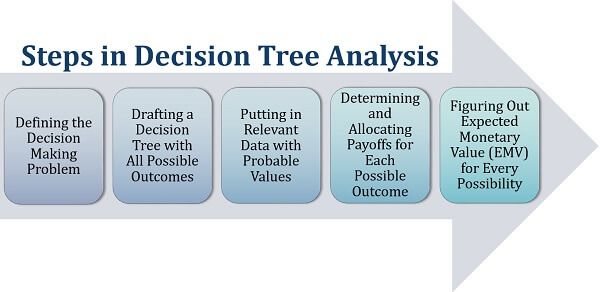
- The first step is understanding and specifying the problem area for which decision making is required.
- The second step is interpreting and chalking out all possible solutions to the particular issue as well as their consequences.
- The third step is presenting the variables on a decision tree along with its respective probability values.
- The fourth step is finding out the outcomes of all the variables and specifying it in the decision tree.
- The last step is highly crucial and backs the overall analysis of this process. It involves calculating the EMV values for all the chance nodes or options, to figure out the solution which provides the highest expected value.
Decision Tree Analysis Example
To enlighten upon the decision tree analysis, let us illustrate a business situation.
ABC Ltd. is a company manufacturing skincare products. It was found that the business is at the maturity stage, demanding some change. After rigorous research, management came up with the following decision tree: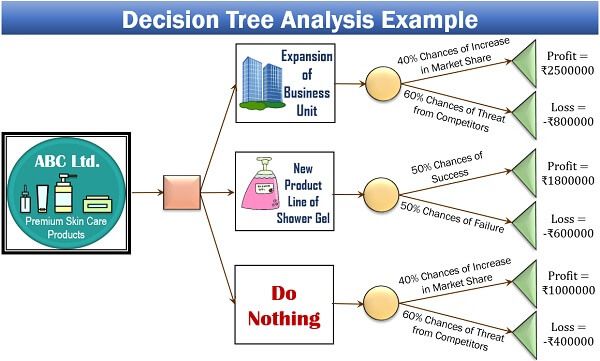
In the above decision tree, we can easily make out that the company can expand its existing unit or innovate a new product, i.e., shower gel or make no changes.
Given below is the evaluation of each of these alternatives:
Expansion of Business Unit:
If the company invests in the development of its business unit, there can be two possibilities, i.e.:
- 40% possibility that the market share will hike, increasing the overall profitability of the company by ₹2500000;
- 60% possibility that the competitors would take over the market share and the company may incur a loss of ₹800000.
To find out the viability of this option, let us compute its EMV (Expected Monetary Value):
New Product Line of Shower Gel:
If the organization go for new product development, there can be following two possibilities:
- 50% chances are that the project would be successful and yield ₹1800000 as profit;
- 50% possibility of failure persists, leading to a loss of ₹800000.
To determine the profitability of this idea, let us evaluate its EMV:
Do Nothing:
If the company does not take any step, still there can be two outcomes, discussed below:
- 40% chances are there that yet, the organization can attract new customers, generating a profit of ₹1000000;
- 60% chances of failure are there due to the new competitors, incurring a loss of ₹400000.
Given below is the EMV in such circumstances:
Interpretation
From the above evaluation, we can easily make out that the option of a new product line has the highest EMV. Therefore, we can say that the company can avail this opportunity to make the highest gain by ensuring the best possible use of its resources.
Advantages of Decision Tree Analysis
Business organizations need to consider various parameters during decision making. A decision tree analysis is one of the prominent ways of finding out the right solution to any problem.
Let us now understand its various benefits below: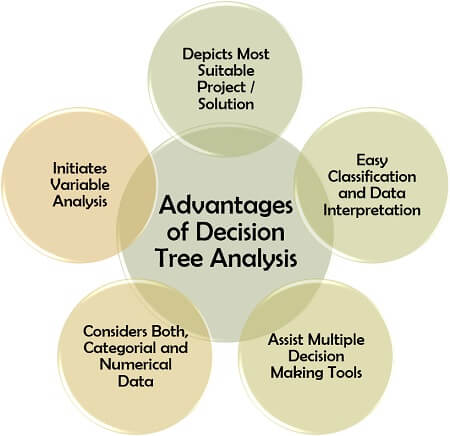
- Depicts Most Suitable Project/Solution: It is an effective means of picking out the most appropriate project or solution after examining all the possibilities.
- Easy Data Interpretation and Classification: Not being rocket science, decision tree eases out the process of segregation of the acquired data into different classes.
- Assist Multiple Decision-Making Tools: It also benefits the decision-maker by providing input for other analytical methods like nature’s tree.
- Considers Both, Categorial and Numerical Data: This technique takes into consideration the quantitative as well as the qualitative variables for better results.
- Initiates Variable Analysis: Its structured phenomena also facilitates the investigation and filtration of the relevant data.
Disadvantages of Decision Tree Analysis
Decision tree analysis has multidimensional applicability. However, its usage becomes limited due to its following shortcomings: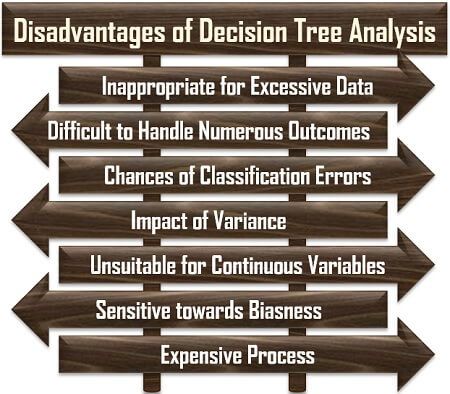
- Inappropriate for Excessive Data: Since it is a non-parametric technique, it is not suitable for the situations where the data for classification is vast.
- Difficult to Handle Numerous Outcomes: If there are multiple possible results of every decision, it becomes tedious to compile all these on a decision tree.
- Chances of Classification Errors: A less experienced decision tree maker usually makes a mistake while putting the variables into different classes.
- Impact of Variance: Making even a slightest of change becomes problematic since it results in a completely different decision tree.
- Unsuitable for Continuous Variables: Incorporating many open-ended numerical variables increases the possibility of errors.
- Sensitive towards Biasness: A decision tree maker may lay more emphasis on preferable variables which may divert the direction of analysis.
- Expensive Process: Collection of sufficient data, its classification and analysis demand high expense, being a resource-intensive process.
Conclusion
In operations research, decision tree analysis holds an equal significance as that of PERT analysis or CPM. It presents a complex decision problem, along with its multiple consequences on paper.
This enables the decision-maker to figure out all the possible options available with him/her and thus, simplifies the task.
Yahya D,Adamu, says
A very good journal with many alternative sujested solutions.